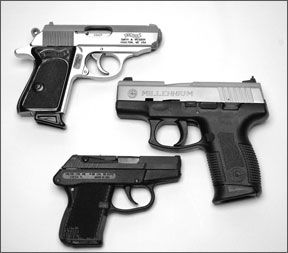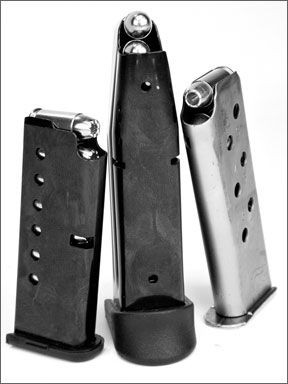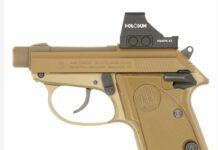When a reader asks, “Which is the best gun for deep concealment?”, or “Is there a good self-defense gun out there with limited recoil?”, our minds immediately turn to guns chambered for 32 Auto (32 ACP).
We understand that many, or most, GT readers would wonder about the 32s power, or lack of same, and that concern was addressed in one part of our test. Beside bench-shooting for accuracy, we also created an action test that focused on what these guns would most likely be used for-that is, rapid fire at little more than contact distance.
In formulating our procedure, we took several factors into account. In close quarters there may be little or no opportunity to apply a support hand. Indeed, the hand opposite of the one holding the gun may be busy fending off a blow, the slash of a knife or, pushing back on the body of the assailant. Therefore, we decided to shoot this drill strong hand only.

The target was placed 9 feet away, and we relied primarily upon point shooting. Three strings would be attempted, making note of accuracy and the elapsed time between shots (split times). Our target was an IDPA-style cardboard silhouette featuring an 8-inch-diameter circle in the upper “chest” area. We aimed for the middle of the circle.
Start position was with the gun held in the right hand of our test shooter just below the point of aim with finger off the trigger. We decided that each string of fire should require that we empty a full magazine into the target. This speaks to the lower available power of 32 ACP, which in most cases produced less than 100 foot-pounds of muzzle energy.
Our test guns in this and other assessments were the $361 Kel-Tec P32PK, an extremely lightweight Parkerized unit; the $573 Walther USA PPK, and the Taurus PT132SSP, $436 with stainless-steel slide. The Kel-Tec was the smallest and could be carried in a pocket holster. The Walther pistol was bigger and heavier but still easy to conceal. The Taurus offered the most capacity.
Each gun was tested for accuracy from a sandbag rest. Test ammunition was American Eagle 71-grain TMJs, 60-grain Winchester Silvertip HP, and Speer Gold Dot 60-grain GDHP rounds. We had intended to limit testing of the Kel-Tec to a distance of 7 yards. But when we saw it print sub-1-inch groups, we decided to shoot the P32PK from 15 yards side by side with the Walter and the Taurus.
Heres what we found:
Kel-Tec P32PK
32 ACP, $361
Its hard to believe that the P32PK weighed in at just 7 ounces. This is a locked-breech semiautomatic with a flush-fitting seven-round magazine. Measuring just 0.8 inches wide, the P32PK was flat enough and light enough to be carried without detection-it could even be dropped naked into a pocket. But we think choosing one of the sheath-like holsters that protect its mechanism from lint or the trigger from loose objects such as coins is a better idea. There are even holsters, such as those from grahamholsters.com, that disguise its profile as a wallet.
The PK suffix stood for Parkerized, which is the black, glare-killing finish found on the top end. The P32PK is Kel-Tecs medium-priced model. Fit with a blue steel slide, the P32 sells for a suggested retail price of $318. Topped with a stainless steel slide, the price was $377. All three guns are the same size, not quite big enough to fill the open hand of an average sized man. With the magazine in place, the base pad completed the front of the grip, measuring only about 1.3 inches from the bottom of the trigger guard. This meant gripping the P32 only required the middle and ring fingers. The sides of the narrow 0.7-inch grip were covered with checkering cleanly molded into the polymer. The 1.8-inch-long backstrap featured vertical lines and a brief palm swell. The magazine release was found at the lower rear corner of the trigger guard on the left side. It operated in the traditional pushbutton manner. Inside the body of the grip was an aluminum sub-frame containing the trigger mechanism and the frame rails. The top of the slide offered enough of a front sight blade to be indexed through the sighting notch at the rear of the slide.
Aside from its small size and light weight, several other characteristics are worth mentioning. We liked the way the magazine clearly showed how many rounds were loaded. The extractor was mounted externally. Double-action ignition was driven by a hammer that stayed nearly out of sight. The trigger would drive back the hammer only after movement of the slide, denying second-strike capability. The pistol was kept narrow by the absence of levers such as a slide release. Locking back the slide was possible only with an empty magazine in place. Removing the top end required the use of a case rim to pry the slide stop pin from the left side of the frame. The owners manual showed someone using the rim of a live round. Call us careful, but we used a spent shell.
From the 7-yard line, our tightest groups (measuring about 0.75 inches on average) were produced with the Winchester Silvertip HP hollowpoints. Second were the American Eagle total metal jackets, followed by the Gold Dot ammunition. From the 15-yard bench the difference in accuracy we achieved shooting these three loads did not seem as pronounced. We concluded that a careful marksman should be able to print five-shot groups that measure about 2.25 inches across with the P32PK.
After our benchrest session we went about hammering targets from close range. Our average elapsed time for emptying the seven-round magazine was 2.24 seconds. The average elapsed time between shots was just less than 0.20 seconds. Fully half of our shots landed inside the desired circle. Another 30 percent were grouped high and to the right. We also saw some shots spread out high and low, mostly to the right. Our wild shots during the action test were likely the result of not working the long trigger consistently in an even manner. In some instances we might also have been applying too much grip upon the little gun or simply trying too hard to go fast.
Walther USA PPK
VAH32002 32 ACP, $573
Walther USA and Smith & Wesson are partners on this gun, an alliance begun several years ago. We were very pleased with the latest PPK acquired for this test.
On the right side flat of the slide, the Walther banner floated above the words Smith & Wesson and a new home city, Houlton, ME. Evidently, the Walther products now have their own facility in Maine far away from the home office in Springfield, Massachusetts. The left side of the slide looked much like the “real” Walther except for the small print that read, “Under License of.” We liked the PPKs squared off edges that looked sharp but were beveled. Likewise, the cocking serrations on the slide and the lines on the paddle of the decocker were surprisingly friendly to the touch. The plastic grip panels looked like collectibles. In short, this pistol had a lot of charm.
Of the three pistols in this test the PPK was the only one that operated by a blowback design. The barrel was connected to the frame, and stayed put while the force of ignition drove the slide to the rear. A large spring that surrounded the barrel pulled it forward again to complete the cycle. The decocker left in the down position deactivated the trigger. To fire, the lever had to be returned manually. Should a hammer blow not ignite a round the first time, the trigger can be reengaged in double action.
Two magazines were supplied. One was capped with a base pad that added more space for the pinky. The other had a flat basepad that helped it seat flush with the bottom of the grip making the pistol more concealable. The plastic grips covered the backstrap and added a palm swell. The magazine release button was placed above the upper rear corner of the trigger guard on the left side of the frame. The button was further protected from accidental release by the slide that skirted over the frame. Mastering a quick release of the magazine took practice.
The sides of the pistol were bright and shiny, but the top of the slide offered two glare-killing treatments. The matte finish was topped with a flat rib that was machined with wavy lines. The front sight showed a red dot deep inside a small hole. The rear sight unit was press-fit into place. It was formed with a glare-cutting chamber and a red vertical line at the center to draw the eye. Both front and rear units looked miniature but were in scale with the rest of the pistol. A chamber-loaded indicator consisted of a pin protruding from the rear of the slide. A channel was machined cleanly across the ribs in the hammer tang so that the indicator would remain visible when the hammer was down. In an age of cost-cutting measures, the PPK had a lot of little features that we could appreciate.
Removing the top end involved pulling down the hinged trigger guard and pushing it aside so that it would remain ajar. Then, we pulled the slide to the rear and lifted it off the frame. The rear of the slide was lifted off first. This drill will probably sound like trouble to most of todays gun owners. Indeed, if the PPK design was poorly executed, this routine could be a nightmare. But it all worked smooth as silk, and no tools were necessary.
From the 15-yard line our largest group measured 2 inches across. Firing the heavier American Eagle ammunition, we landed several groups measuring less than 1.5 inches. The Winchester Silvertip HPs were not far behind. In our action test the PPK cycled quickly, and the 32-caliber ammunition offered no “kick” whatsoever.
The PPK featured all-steel construction, and being narrow, fit deeply into the shooters hand. Each round lit off with a sharp snapping sound, and the PPK was really a ball to point shoot. Seventy percent of our shots landed inside the circle. The remaining hits were just across the line above and to the right. In terms of speed, our seven-shot strings were completed in an average elapsed time of 2.17 seconds from audible start signal. The average elapsed time between shots was just less than 0.16 seconds. These are fast split times, but consider the following. The first shot was double action, and the trigger presented a whopping 15 pounds of resistance to the shooter. Subsequent shots were single action only, but they still required a relatively heavy 7 pounds of pressure. However, our test shooter never really felt the trigger. He said he was just trying to keep up.
We did suffer one malfunction wherein the slide locked back before the magazine was empty. This occurred while feeding from the

magazine with the flat base pad in place. Perhaps upward pressure from our pinky that had no place to ride other than beneath the magazine forced the slide stop into stalling the action. Despite nearly exhausting our supply of ammunition, we were never able to duplicate this lone stoppage.
Taurus Millennium Pro
PT132SSP 32 ACP , $436
The Millennium Pro or PT series pistols are available with blue or stainless steel slide. They can be chambered for calibers as small as 32 Auto and as large as 45 ACP. We counted no less than 14 different models listed on the taurususa.com website. Key attributes of this double-action-only pistol was its high-capacity magazine, stubby dimensions and light weight. We would refer to the ignition system as a striker-fired mechanism, but Taurus calls the source of impact a firing pin.
The Taurus action had double-strike capability. This meant if a round did not ignite the first time, the trigger can be pulled repeatedly. Actually, we noticed that movement of the slide was not necessary to cock the firing mechanism. Rather than offer a mechanical decocker, the PT132SSP was fit with a thumb-operated safety on the left side of the frame. In addition there were two internal safeties. One acted to preclude rearward movement of the trigger in the event the pistol was dropped. The other safety was a firing-pin block that held the pin in check until the trigger was at the end of its rearward stroke. The upper surface of the externally mounted extractor was hinged so that it would bulge outward when the chamber was loaded. The action could be stalled by a key-operated lock located on the right hand side of the slide.
The sights were very clear. Up front was a tall blade on a stanchion enhanced with a white dot. The rear unit was tall and adjustable for windage only. The rear blade was plain and did not offer dots to complement the front sight. Our staff thought this view was ideal. The slide was matte-finished stainless steel. Field-stripping required pressing the trigger, so we double-checked for an empty chamber. Then the slide was pulled to the rear and locked into place. We liked not having to fight against the recoil spring while removing the takedown pin. The pin, found on the left side of the frame, was rotated 90 degrees to the 6 oclock position and removed. Releasing the slide and pressing the trigger allowed the top end to move forward off the frame. Underneath was a plunger-type recoil assembly with two captured springs. Removing or installing this part was easy because the fit of the recoil assembly between the barrel lug and the front of the slide was without any real tension. The only tricky part about reassembly came after the slide was applied to the frame. The barrel was free to shift back and forth. To align the notch in the barrel lug with the hole for the breakdown pin, we simply tilted the gun forward. This caused the barrel to come to rest in the proper position for seating the pin.
Handling the PT132SSP at the range, we found that the smooth 6.5-pound trigger combined with its excellent ergonomics and clear sight picture gave us lots of confidence. Capacity was listed as being 10+1, but we were not able to fit the tenth round in either of our two supplied magazines. Firing carefully from the bench, we found that the Taurus preferred the American Eagle TMJ rounds. They produced the smallest single group overall, measuring 1.2 inches across. Of our two defensive rounds, firing the Winchester Silvertip HP rounds produced 2.0-inch groups on average. Groups printed by the Gold Dot ammunition were about an inch bigger. The Silvertips also produced the most power. However, we suffered a malfunction firing the Silvertips, wherein a spent case failed to completely clear the ejection port.
Despite the earlier malfunction we went into our action test with the Millennium Pro full of confidence. The excellent sights, the promise of less recoil from the weight of the high capacity magazines, and the graceful trigger all led us to believe we were going to deliver our shots in style. We began our action test firing the Winchester Silvertip HP rounds to see if the earlier stoppage would reoccur. Our first run produced a tight three-inch group centered in the upper half of the circle. Then we ran into trouble. Problems commonly referred to as double-feeds and stovepipes persisted even when we changed to the American Eagle ammunition. One run was cut short, ending with a light hit on the primer of the ninth shot. But we were able to compute an average split time of about 0.20 seconds between shots.
If we were to guess what caused the majority of malfunctions we might say that it was a classic case of limp wristing. This term is typically used to describe a situation wherein the pistol is not adequately stabilized in the hand. A loose grip can act like a shock absorber and drain necessary energy from reciprocation of the slide. Given our action test was performed with only one hand on the gun this is entirely possible.
Perhaps the loose fitting recoil assembly was a contributing factor. Then again, we would point out that both the Walther and the Kel-Tec pistols were designed as small-caliber machines. The Millennium Pro impressed us as being a full-size gun. Perhaps the adaptation to a relatively weak round such as 32 ACP made the gun more vulnerable to critical parts or shooter error.
0508-Taurus-Millennium-Pro.pdf




























